Mictlantecuhtli, the enigmatic Lord of the Underworld, occupies a central role in the rich tapestry of Aztec mythology. Understanding this deity is not only a journey into the heart of Aztec spirituality but also an exploration of the complex relationship between life and death in their belief system. In this comprehensive article, we delve deep into the fascinating realm of Mictlantecuhtli, unearthing the symbolism, rituals, and myths that make him a significant figure in the pantheon of Aztec gods. Join us on this enlightening voyage through the mysteries of the Aztec underworld and the god who presides over it.
| Attribute | Mictlantecuhtli Information |
|---|---|
| Origin | Aztec Mythology |
| Deity Type | God of the Dead and Ruler of Mictlan (the Underworld) |
| Appearance | Often depicted as a skeletal figure or a decomposed corpse |
| Role | God associated with death, the afterlife, and the underworld |
| Mictlan | Ruled over Mictlan, the Aztec realm of the dead, where souls journey after death |
| Cultural Impact | A central figure in Aztec beliefs about death and the afterlife |
| Depictions | Featured in Aztec art and rituals, particularly those related to death and funerary practices |
1. Origin and Mythological Background
Origins of Mictlantecuhtli
Mictlantecuhtli, the formidable deity of the underworld, finds his origins deeply rooted in the rich tapestry of Aztec mythology. His story unfolds in the primordial epochs of the Aztec universe, where the struggle for supremacy between gods and cosmic forces set the stage for his emergence.
In Aztec cosmology, it is believed that before the creation of the world as we know it, there was only a vast, watery abyss. In this abyss, two powerful primordial deities, Ometecuhtli and Omecihuatl, the Lord and Lady of Duality, resided. From their union emerged four divine beings, one of whom was Mictlantecuhtli. These four deities represented the cardinal directions and cosmic elements, with Mictlantecuhtli symbolizing the north and the element of earth.
The Lord of the Underworld
Mictlantecuhtli’s significance in Aztec mythology lies in his role as the Lord of the Underworld, Mictlan. Mictlan was the realm of the dead, the final destination for the souls of the departed. As the ruler of this domain, Mictlantecuhtli governed the fate of souls after death. His appearance was befitting of his dominion, depicted as a skeletal figure, often adorned with bells and wearing a headdress made of owl feathers.
The Aztecs believed that upon death, a soul’s journey was fraught with peril, with challenges and obstacles that it must overcome to reach Mictlan. Mictlantecuhtli’s role was not merely that of a fearsome deity, but also as the judge who determined the fate of these souls. He presided over the scales that weighed the hearts of the deceased against a feather, symbolizing the balance of good and evil deeds in life.
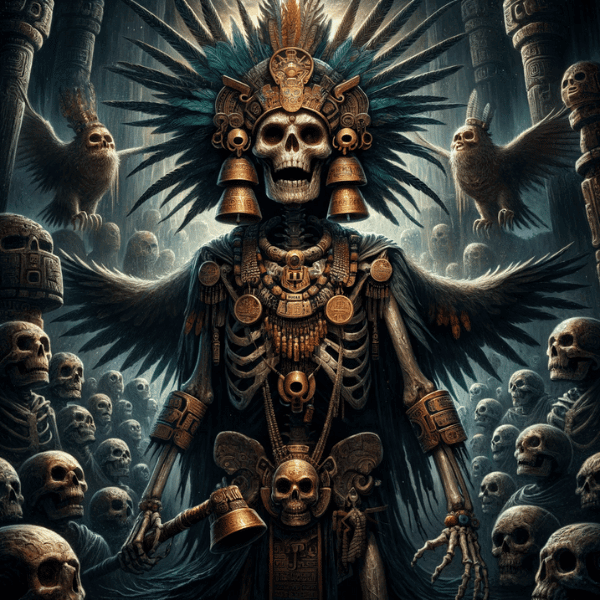
The Aztec Cosmology and the Underworld
To fully appreciate Mictlantecuhtli’s significance, one must understand the intricacies of Aztec cosmology. The Aztecs believed in a universe divided into thirteen heavens and nine underworlds. Earth, or the mortal realm, known as Tlalticpac, occupied the central position in this cosmic structure.
The underworlds were of particular importance in Aztec cosmology, with Mictlan situated in the lowest level. These realms represented the stages of the soul’s journey after death, with each level presenting distinct challenges and trials. The final destination, Mictlan, was the eternal resting place for most souls, where they would endure a peaceful afterlife.
Mictlantecuhtli’s significance extended beyond his role as the lord of Mictlan; he played a pivotal role in maintaining the cosmic balance. The cycles of life and death were intertwined with his existence, symbolizing the perpetual renewal of existence in the Aztec worldview.
2. Appearance and Symbolism
Mictlantecuhtli’s Physical Appearance
Mictlantecuhtli’s physical appearance is a striking testament to the profound symbolism embedded within Aztec mythology.He often appears as a skeletal figure with prominently visible bones, hollow eye sockets, and may hold a scepter adorned with a skull or have his mouth agape in a menacing grin. Skeletal form of Mictlantecuhtli is a stark contrast to the vibrant and diverse pantheon of Aztec gods, making him an instantly recognizable deity in Aztec art and iconography.
The skeletal imagery extends to his limbs, fingers, and toes, leaving no doubt that he personifies death and decay. He often wears a headdress made of owl feathers, further connecting him to the night and darkness, emphasizing his role as the lord of the underworld.
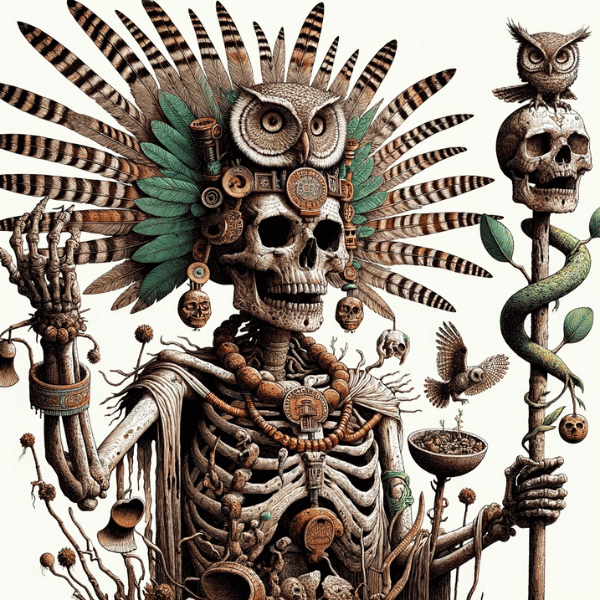
Symbolism Behind His Appearance
The symbolism behind Mictlantecuhtli’s skeletal appearance is layered and profound, reflecting fundamental aspects of Aztec belief and cosmology:
- Death and Rebirth: Mictlantecuhtli’s skeletal form represents the inevitable and inescapable nature of death. In Aztec cosmology, death was not an end but a transition to another phase of existence. His skeletal appearance symbolizes the transformation from life to death and the potential for rebirth. It underscores the cyclical nature of life and death in the Aztec worldview, where death was not feared but embraced as a necessary part of the cosmic order.
- Fertility and Agriculture: Paradoxically, Mictlantecuhtli’s skeletal form also carries associations with fertility and agriculture. The Aztecs believed that death and rebirth were connected to the earth itself. They sometimes invoked Mictlantecuhtli in agricultural rituals to ensure the fertility of the land and the success of crops. His skeletal imagery reminded the Aztecs of the cycle of decay and renewal that was essential for sustaining life.
- Night and Darkness: As the lord of the underworld, Mictlantecuhtli was closely linked to the night and darkness. His owl feather headdress and association with nocturnal creatures reinforced this connection. Nighttime, in Aztec belief, was a time of rest and regeneration, much like the journey of the soul in the underworld. Mictlantecuhtli’s skeletal form and affiliation with darkness symbolized the peaceful reprieve that death brought to the departed souls.
3. Worship and Rituals
Worship of Mictlantecuhtli
The Aztecs held a deep reverence for Mictlantecuhtli, recognizing the pivotal role he played in the cycle of life and death. Worship of the Lord of the Underworld was integral to their spiritual practices, and various rituals and ceremonies were dedicated to him.
Rituals and Offerings
One of the most significant rituals dedicated to Mictlantecuhtli was the Huey Tozoztli festival, also known as the Great Vigil. This annual event, held in the Aztec month of Tozoztli, involved elaborate ceremonies and offerings. During the Huey Tozoztli, the Aztecs would present offerings to Mictlantecuhtli, often including items such as:
- Food Offerings: The Aztecs offered a variety of foods, including maize, beans, and amaranth, which held cultural significance as staples of their diet. These offerings were meant to sustain the deceased in the afterlife.
- Incense and Copal: During ceremonies, people burned aromatic incense and copal resin as a means of purification and as offerings to Mictlantecuhtli. They believed that the fragrant smoke facilitated communication with the divine.
- Tobacco and Intoxicants: People sometimes included tobacco and pulque, a traditional alcoholic beverage, in offerings to Mictlantecuhtli. These substances played a role in Aztec religious rituals, helping to alter consciousness and connect with the spirit world.
- Sacrifices: In some instances, people and animals made sacrifices to honor Mictlantecuhtli. They typically reserved these offerings for specific occasions, viewing them as a way to appease and honor the deity.
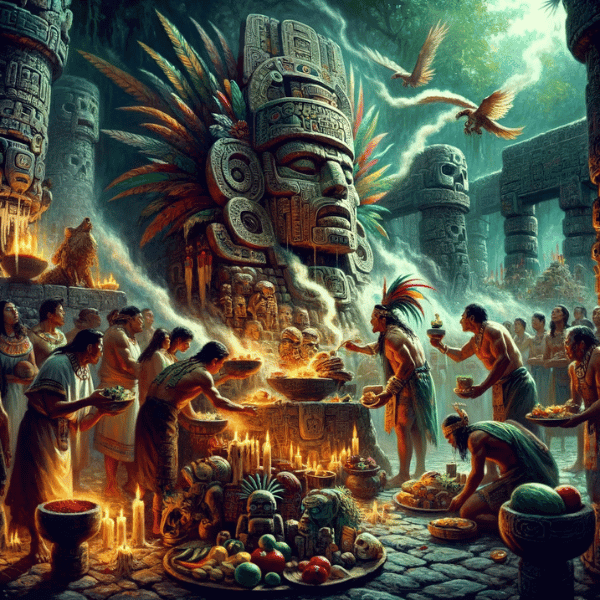
Significance of Honoring the God of the Underworld
Honoring Mictlantecuhtli held profound significance in Aztec culture. It was a recognition of the inevitable and cyclical nature of life and death. By paying homage to the Lord of the Underworld, the Aztecs sought to maintain harmony within the cosmos and ensure a safe journey for the souls of the departed.
Moreover, Mictlantecuhtli’s worship was not limited to death rites but also extended to agricultural rituals. The Aztecs believed that the god’s influence was crucial for the fertility of the land and the success of their crops. By appeasing Mictlantecuhtli through offerings and ceremonies, they hoped to ensure bountiful harvests and the continuation of life’s vital cycles.
In essence, honoring Mictlantecuhtli was an act of acknowledging the interconnectedness of life and death, the earthly realm and the underworld, and the spiritual and material worlds. It was a testament to the Aztec’s profound understanding of the cosmic order and their commitment to maintaining balance within it.
4. Mictlantecuhtli’s Role in Creation Myths
Mictlantecuhtli and the Creation of Humanity
Mictlantecuhtli’s significance in Aztec creation myths is both intriguing and profound. In Aztec cosmology, the world had gone through several cycles of creation and destruction before the current epoch. Each of these cycles was associated with a different sun, or era, with its own set of gods.
According to one prominent creation myth, Mictlantecuhtli played a crucial role in the birth of the fifth sun, which is the present era. In this myth, the god Nanahuatl, a humble deity, was chosen to become the new sun. However, Nanahuatl’s radiant form was too weak to rise into the sky on its own. To ensure the success of this new era, another god, Tezcatlipoca, made a tremendous sacrifice. He transformed himself into a jaguar and leaped into the flames, enabling the sun to ascend.
Mictlantecuhtli’s role in this myth is that he and his consort, Mictecacihuatl, were responsible for creating humanity from the bones of the previous generation of gods. They ground the bones of the deceased gods into a fine powder, mixed it with blood, and molded it into the first human beings, thus giving birth to humanity.
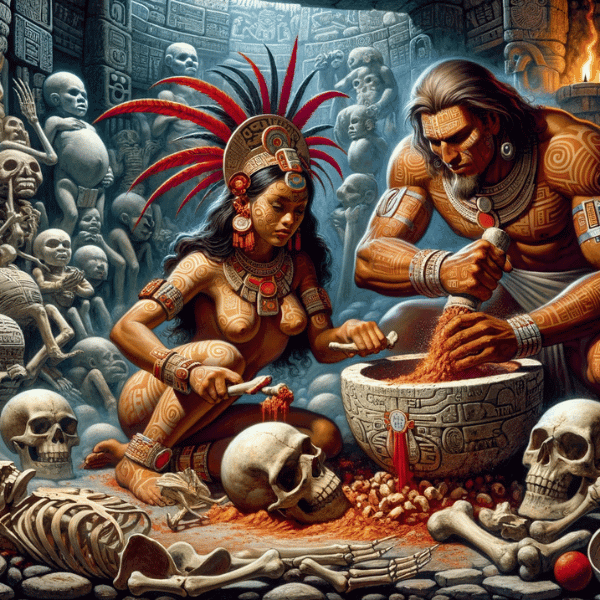
The Balance Between Life and Death in Aztec Mythology
Aztec mythology places immense emphasis on the delicate balance between life and death. Mictlantecuhtli’s role integrally ties to the balance represented by the dualities found throughout their belief system, such as day and night, light and darkness, and creation and destruction. Mictlantecuhtli serves as a reminder that death is an inherent part of the cycle of life.
In Aztec belief, death was not viewed as the end but as a transformative stage in the cyclical journey of the soul. Mictlantecuhtli, as the lord of the underworld, played a crucial part in guiding the deceased souls through this journey. The god’s skeletal appearance symbolized the transformation from life to death and, by extension, the potential for rebirth in the next cycle of existence.
The Aztecs recognized the interdependence of life and death, understanding that one could not exist without the other. Mictlantecuhtli embodied this concept, emphasizing the need for balance and harmony in the cosmic order. By acknowledging the lord of the underworld in their creation myths and rituals, the Aztecs honored this delicate equilibrium and sought to ensure the continuation of life and the renewal of the world.
5. Cultural Significance and Influence
Cultural Significance of Mictlantecuhtli in Aztec Society
Mictlantecuhtli’s influence permeated every facet of Aztec society, leaving an indelible mark on their culture, art, and literature. His role as the lord of the underworld and the guardian of the deceased souls held immense cultural significance:
- Religious Ceremonies: Mictlantecuhtli was a central figure in religious ceremonies and rituals, especially those related to death and the afterlife. The Aztecs held annual festivals, such as the Huey Tozoztli, to honor him and ensure the safe passage of the deceased to the underworld.
- Art and Iconography: The god’s distinctive skeletal appearance, with its prominent skeletal features and owl feather headdress, was a common motif in Aztec art. His image adorned temples, codices, pottery, and various artifacts, serving as a constant reminder of the importance of life’s transitory nature.
- Mythological Stories: Mictlantecuhtli featured prominently in Aztec mythology and creation stories, reinforcing his role as a foundational deity in their belief system. Generations passed down these myths, shaping the Aztec worldview and their understanding of life, death, and rebirth.
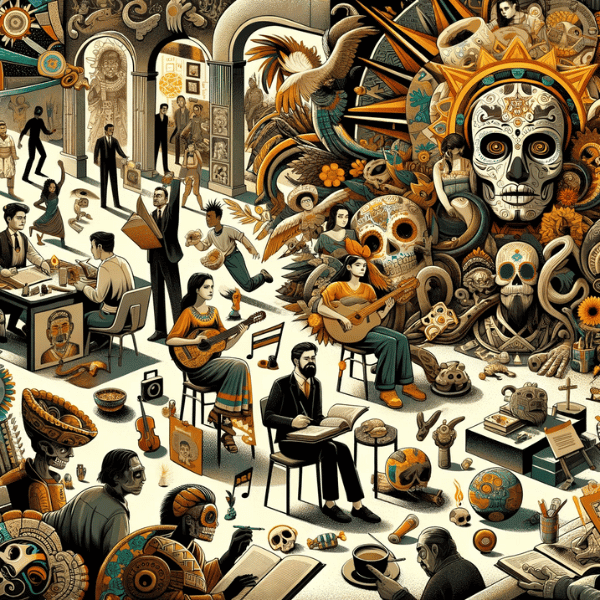
Influence on Contemporary Art and Culture
Mictlantecuhtli’s imagery and stories continue to resonate in contemporary art and culture, both within and beyond the Aztec homeland. His impact extends far beyond the borders of ancient Mexico:
- Artistic Inspiration: Artists worldwide draw inspiration from Mictlantecuhtli’s striking skeletal form and intricate symbolism. Modern paintings, sculptures, and even tattoo art feature his image, serving as a powerful symbol of life’s cyclical nature.
- Literary References: Contemporary literature reflects Mictlantecuhtli’s presence, especially in works exploring themes of life, death, and the afterlife. Authors and poets have woven elements of Aztec mythology into their narratives, paying homage to the lord of the underworld.
- Cultural Celebrations: The influence of Mictlantecuhtli is evident in cultural celebrations like Dia de los Muertos (Day of the Dead), a Mexican holiday that honors deceased loved ones. His skeletal imagery and the idea of celebrating the departed souls echo the Aztec belief in the continuation of life beyond death.
6. Conclusion
In the comprehensive exploration of Mictlantecuhtli, the Aztec God of the Underworld, we have uncovered a deity deeply woven into the tapestry of Aztec mythology. Originating from the primordial forces of creation, Mictlantecuhtli’s skeletal form and enigmatic symbolism embody the delicate balance between life and death in Aztec belief. The Aztecs’ worship, rituals, and ceremonies dedicated to him were a testament to their recognition of this eternal cycle. Today, Mictlantecuhtli’s cultural significance endures, resonating in art, literature, and cultural celebrations. His legacy serves as a bridge between the ancient world and the present, a reminder of the timeless themes of transformation, rebirth, and the interconnectedness of all existence. As we conclude this exploration, we encourage further curiosity and exploration of Aztec mythology, inviting readers to delve deeper into the captivating stories of gods, heroes, and creatures that continue to inspire and intrigue.
